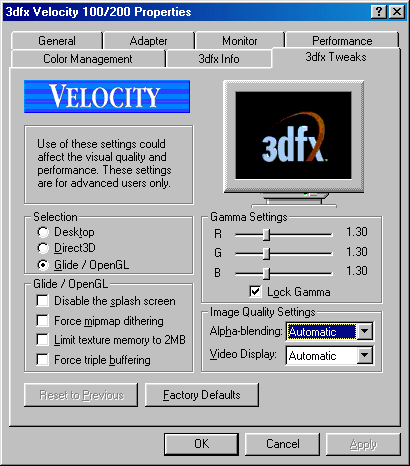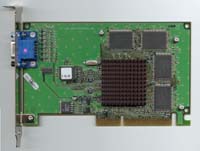The Card
The Velocity 100 is a bit smaller then the Voodoo3 2000/3000 cards, but not much. However, the layout is considerably cleaner than those cards, primarily because it offers no option for TV-out.
The heatsink is identical to the one used on the Voodoo3 2000. However, at least in this case, it’s attached less than optimally, using thermal glue that is not applied properly, leaving a large gap between the heatsink and the chip.
Our sample featured four 6ns 2MB SGRAM chips from Siemens. It’s interesting to note that 6ns RAM is designed to run at 166 MHz, despite the fact that the Velocity only runs it at 143 MHz. This of course practically begs you to overclock the card. All Voodoo3 series cards, including the Velocity, run the memory and core clocks synchronously (ie they cannot be set independently).
Our sample would run at 166/166 with just a few visual anomolies, while 160/160 was completely stable. Since the memory is designed for 166 MHz operation, 166 for the core is either causing the chip to overheat or we’ve reached the limit of our particular sample. We’ve already noted that the heatsink is not particularly well mounted; it appears that it’s overheating. With some additional cooling, 166/166 operation should easily be attainable. Note that SGRAM has traditionally not overclocked particularly well, so going significantly beyond 166/166 is not likely to happen.
As always, overclocking results will vary from card to card.
Drivers
As mentioned above, the drivers for the Velocity appear to be very closely based on those of the Voodoo3. That means a full OpenGL ICD is included for Windows 9x and NT 4.0, full DirectX/Direct3D support for Windows 9x, and, exclusive to 3dfx, Glide support under Windows 9x and NT. Fortunately for users of non-3dfx cards, but unfortunately for 3dfx themselves, the need for Glide has been diminishing greatly in recent times.
While the Voodoo3 drivers would not work directly on the Velocity, all the filenames were the same. To modify the Voodoo3 drivers to work on the Velocity, we simply had to use the Velocity’s .inf file with the Voodoo3 drivers. There was no performance difference between the drivers on the Velocity CD and the latest from the 3dfx website. It’s nice to know, however, that the Velocity should be able to use Voodoo3 drivers in the future if 3dfx ever stops supporting the card.
The driver CD also included the same 3dfx Tools that came with the Voodoo3, with one minor change – the Velocity logo is now in place. Screenshots of these tools are shown below. Notice how the information tab does actually give a fair amount of information about the card. Also important to note is the fact that there is no option for disabling vsync directly in the drivers – a third party utility, such as Powerstrip, will be necessary for this task.













1 Comments
View All Comments
KostNalu - Thursday, June 13, 2019 - link
It was my first 3dfx card back in the day. It was a good old days back then. I miss those Glide games.